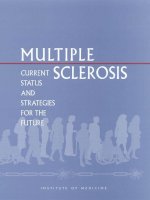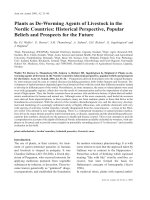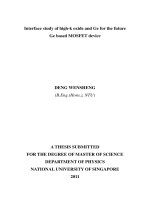best of toc 3e analysis and ideas about the future of publishing full
Bạn đang xem bản rút gọn của tài liệu. Xem và tải ngay bản đầy đủ của tài liệu tại đây (2.55 MB, 266 trang )
Best of TOC, 3rd Edition
TABLE OF CONTENTS
Special Upgrade Offer
1. Introduction
2. Innovation
How Agile Methodologies Can Help Publishers
What is an agile methodology?
How do agile methodologies apply to publishing?
Taking a Page Out of ESPN’s Playbook
Pay for one, access all
Building talent franchises
Memorable quotes
Perceptive Media: Undoing the Limitations of Traditional Media
How does Perceptive Media work, and are there privacy concerns?
What driving factors are pointing to the success of this kind of
storytelling platform?
In the early days, Perceptive Media is being applied to broadcast
technology. What potential applications for Perceptive Media do you
envision in the publishing industry?
Kindle Fire vs iPad: “Good Enough” Will Not Disrupt
How disruptive is the Kindle Fire to the low-end tablet market?
Is Amazon a threat to Apple?
What role do you see Apple playing in the future of publishing — and
what current trends do you identify as driving factors?
Don’t Build Social — Thoughts on Reinventing the Wheel
Services, APIs, and the Complex Web
Publishing focus and third-party opportunity
Startups and Publishers: It Ain’t Easy
If you sell a product publishers don’t want, who is to “blame”?
Solutions to solve future problems
Where to next?
The risk of ceding the future to other players
In the end, readers will drive the change
It’s Time for a Publishing Incubator
Roadblocks
People have been thinking about this for awhile
The publishing incubator
The Slow Pace of eBook Innovation
Putting a Value on Classic Content
Reading Experience and Mobile Design
Mobile design?
Five convergence points for mobile design & reading system design
Serial Fiction: Everything Old Is New Again
Why should you be interested in serial fiction?
Frequency, engagement, and experimentation
It still comes down to great writing
3. Revenue Models
Getting the Content Out There Isn’t Enough Anymore
In what contexts does content aggregation create the most value?
How about paywalls — is anyone doing this properly? What is the best
way to make this model work?
24Symbols is based on a subscription model. Since your launch, have you
had to change the model to make it work?
Amazon, eBooks, and Advertising
New Life for Used eBooks
In-Book Purchases
Why a Used eBook Ecosystem Makes Sense
4. Rich Content
In the Case of Interactivity, We’re Still at the Phase of Irrational
Enthusiasm
Where do you draw the line between meaningful and gimmicky
interactivity?
Are there times when interactivity is detrimental and should be avoided?
How have mobile platforms changed the publishing landscape?
What kinds of tools do authors need to create interactive content, and
what new skills might they need to develop?
What are some guidelines authors should follow when considering
interactive features for content?
How should one decide between building an ebook and building an app?
Is there a tipping point?
Are eBooks Good Enough Already?
5. Data
Transforming Data into Narrative Content
What does Narrative Science do and how are you applying the technology
to journalism?
How does data affect the structure of a story?
What kinds of stories lend themselves well to this type of system and
why?
What kinds of stories just won’t work — what are the boundaries or
limitations?
In what ways can publishers benefit from Narrative Science?
In what other industries are you finding applications for Narrative
Science?
Book Marketing Is Broken. Big Data Can Fix It
What are some key findings from the Bookseer beta?
What kinds of data are most important for publishers to track?
What does real-time data let publishers do?
How would you describe the relationship between sales and social media?
Will Retailers Start Playing Big Brother with Our Content?
6. DRM & Lock-in
It’s Time for a Unified eBook Format and the End of DRM
Platform lock-in
The myth of DRM
Lessons from the music industry
“Lightweight” DRM Isn’t the Answer
Kindle Remorse: Will Consumers Ever Regret eBook Platform Lock-in?
Neutralizing Amazon
Kindle Serials Is the Next Brick in Amazon’s Walled Garden
7. Open
Publishing’s “Open” Future
Content access via APIs
Evolution of DRM
Apps, platforms, formats, and HTML5
Let’s open this up together
Free and the Medium vs. the Message
Free as in freedom (and beer)
Information and delivery
Creating Reader Community with Open APIs
Reading is more than a solitary activity
The new era of data-driven publishing
The consequences of walled gardens
Buy Once, Sync Anywhere
The problem — a fragmented content ecosystem
The proposed solution — an API to share a user’s purchase information
What would the access permission API look like?
Concept basis of a specification
A common data transfer medium
The future
8. Marketing
The Core of the Author Platform Is Unchanged — It’s the Tools that Are
Rapidly Changing
What is an “author platform” and how is it different today from, say, 10
years ago?
What are some of the key ways authors can connect with readers?
In marketing your book Cooking for Geeks, what were some of the most
successful tactics you used?
What advice would you offer to new authors just starting out?
The Sorry State of eBook Samples, and Four Ways to Improve Them
How Libraries Can Help Publishers with Discovery and Distribution
How to De-Risk Book Publishing
Selling Ourselves Short on Search and Discovery
The 7 Key Features of an Online Community
Book Communities
The Fundamentals
Conclusion
9. Direct Sales Channel
Direct Sales Uncover Hidden Trends for Publishers
Direct Channels and New Tools Bring Freedom and Flexibility
Direct Channels
Evolving Tools
It’s the Brand, Stupid!
NY Times eBook Initiative Could Be So Much More
10. Legal
Fair Use: A Narrow, Subjective, Complicated Safe Haven for Free Speech
How is “fair use” defined and what is its legal purpose?
Does the breadth of the fair use guidelines cause confusion?
What are some best practices people should follow to stay within the
guidelines?
What are the most common fair use abuses?
What kinds of content aren’t protected by copyright or subject to fair use?
How would someone know if something is in the public domain or not?
What’s your take on Creative Commons licensing?
eBook Lending vs Ownership
A Screenshot, a Link, and a Heap of Praise Are Met with a Takedown
Notice
11. Formats
Portable Documents for the Open Web (Part 1)
What’s up with HTML5 and EPUB 3? (and, is EPUB even important in
an increasingly cloud-centric world?)
The Enduring Need for Portable Documents
Portable Documents for the Open Web (Part 2)
Portable Documents for the Open Web (Part 3)
Graceful eBook Degradation
IOS 6, Android, HTML5: Which Publishing Platform Prevails?
Responsive eBook Content
HTML5, EPUB 3, and eBooks vs Web Apps
Your mileage may vary, especially on the Nook
Distinguishing apps from ebooks
eBooks as Native Apps vs Web Apps
Distinguishing ebooks from apps
Closing the gap between HTML5 and EPUB 3 support
Books as Apps Deserve Serious Consideration
12. Pricing
Piracy, Pricing, and eBook Hoarding
Page Count, Pricing, and Value Propositions
The Future Is Bright for eBook Prices and Formats
Pricing
Formats
13. Production
The New New Typography
Browser as typesetting machine
The power of CSS and JavaScript
Ease and efficiencies
BookJS Turns Your Browser into a Print Typesetting Engine
Ebook Problem Areas that Need Standardisation
Overrides
Annotations
Modularised EPUB
Staying out of CSS
Graceful degradation for Fixed Layout
What else?
InDesign vs CSS
Math Typesetting
What’s the hold up?
So why is this really interesting to publishing?
WYSIWYG vs WYSI
A Kindle Developer’s 2013 Wishlist
1. Add support for embedded audio/video to Kindle Fire
2. Add KF8 support for MathML
3. Add a Monospace Default Font to Kindle Paperwhite
4. Add more granularity to @media query support
5. Add a “View Source” option to Kindle Previewer
Special Upgrade Offer
Best of TOC, 3rd Edition
O’Reilly TOC Team
Beijing • Cambridge • Farnham • Köln • Sebastopol • Tokyo
Special Upgrade Offer
If you purchased this ebook directly from oreilly.com, you have the following
benefits:
DRM-free ebooks — use your ebooks across devices without restrictions
or limitations
Multiple formats — use on your laptop, tablet, or phone
Lifetime access, with free updates
Dropbox syncing — your files, anywhere
If you purchased this ebook from another retailer, you can upgrade your
ebook to take advantage of all these benefits for just $4.99. Click here to
access your ebook upgrade.
Please note that upgrade offers are not available from sample content.
Chapter 1. Introduction
2012 was quite a year for change in the publishing industry. Throughout the
year we used the TOC community site to provide insightful analysis of the
latest industry developments. And since ours is a community site, the articles
we publish aren’t just from the TOC team; we also feature perspectives from
many of the top innovators and publishing experts.
It wasn’t easy, but we hand-picked the most noteworthy articles from 2012
for inclusion in this Best of TOC collection. We think you’ll agree that the
more than 60 pieces featured here represent some of the most thoughtprovoking dialog from the past year. We’ve arranged the articles by category,
so whether you’re most interested in marketing, revenue models, production
or innovation in general you’ll find something to get your creative juices
flowing.
And since we’re all about fostering community at TOC we hope this
collection will encourage you to add your voice to the discussion. Since each
of these articles is taken from our website you can add your comments by
searching for the headline on toc.oreilly.com.
Chapter 2. Innovation
How Agile Methodologies Can Help Publishers
By Jenn Webb
Agile methodologies originated in the software space, but Bookigee CEO
Kristen McLean (@ABCKristen) believes many of the same techniques can
also be applied to content development and publishing workflows. She
explains why in the following interview.
What is an agile methodology?
Kristen McLean: An agile methodology is a series of strategies for
managing projects and processes that emphasize quick creative cycles, flat
self-organizing working groups, the breaking down of complex tasks into
smaller achievable goals, and the presumption that you don’t always know
what the finished product will be when you begin the process.
These types of methodologies work particularly well in any situation where
you are trying to produce a creative product to meet a market that is evolving
— like a new piece of software when the core concept needs proof from the
user to evolve — or where there needs to be a very direct and engaged
relationship between the producers and users of a particular product or
service.
Agile methodologies emerged out of the software development community in
the 1970s, but began to really codify in the 1990s with the rise of several
types of “lightweight” methods such as SCRUM, Extreme Programming, and
Adaptive Software Development. These were all rolled up under the umbrella
of agile in 2001, when a group of developers came together to create the
Manifesto for Agile Software Development, which set the core principles for
this type of working philosophy.
Since then, agile has been applied outside of software development to many
different kinds of systems management. Most promote development,
teamwork, collaboration, and process adaptability throughout the life-cycle of
the project. At the end of the day, it’s about getting something out there that
we can test and learn from.
How do agile methodologies apply to
publishing?
Kristen McLean: In relation to publishing, we’re really talking about two
things: agile content development and agile workflow.
Agile content development is the idea that we may be able to apply these
methodologies to creating content in a very different way than we are
traditionally used to. This could mean anything from serialized book content
to frequent releases of digital content, like book-related websites, apps,
games and more. The discussion of how agile might be applied to traditional
book content is just beginning, and I think there’s an open-ended question
about how it might intersect with the deeply personal — and not always
quick — process of writing a book.
I don’t believe some of our greatest works could have been written in an agile
framework (think Hemingway, Roth, or Franzen), but I also believe agile
might lend itself to certain kinds of book content, like serial fiction (romance,
YA, mystery) and some kinds of non-fiction. The real question has to do with
what exactly a “book” is and understanding the leading edge between
knowing your audience and crowdsourcing your material.
Publishing houses have been inherently hierarchical because they’ve been
organized around a manufacturing process wherein a book’s creation has
been treated as though it’s on an assembly line. The publisher and editor have
typically been the arbiters of content, and as a whole, publishers have not
really cultivated a direct relationship with end users. Publishers make. Users
buy/read/share, etc.
Publishers need to adapt to a radically different way of working. For
example, here’s a few ways agile strategies could help with the adaptation of
a publishing workflow:
Create flat, flexible teams of four to five super-talented individuals with a
collective skill set — including editorial, marketing, publicity, production,
digital/design, and business — all working together from the moment of
acquisition (or maybe before). These teams would need to be completely
fluent in XHTML and would work under the supervision of a managing
publisher whose job would be to create the proper environment and









